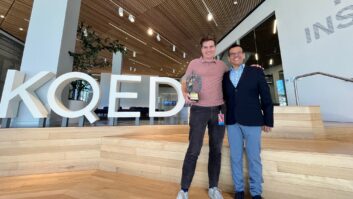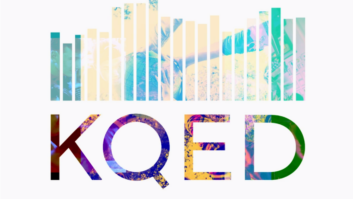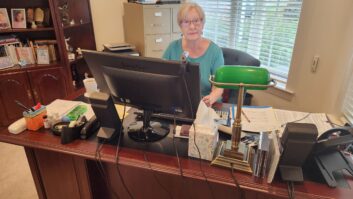There are many pressures pushing radio toward an all-IP world. Connectivity appears to be on the path to ubiquity, and smartphones are now the most universal personal device (displacing the radio set). Apps can be functional, attractive and measureable. Traditional radio seems to have reached the limits of its flexibility, whereas IP appears to have limitless opportunities.
Broadcast technology has an image problem. If it were to be invented today by Apple or Google, broadcast might be called �a wide-area, highly scalable, reliable, economic multimedia distribution platform.� It might even make use of technology like eMBMS, which is intended to support live media over mobile networks, by using spare spectrum to create weak broadcast signals from expensive cellular infrastructure.�
The broadcasting aspect is what makes radio big. It�s really that simple. If your ambition is to run a big radio station, broadcast has been and will always be an appropriate technology. It uses little power on the receiver, has reliable coverage and uses no mobile data. It is intrinsically more cost-effective than trying to achieve the same coverage using densely populated cell towers.

Hybrid radio is about preserving the core value of our legacy broadcast technology, and modernizing it so it fits in our new IP-centric world. Hybrid radio has all the benefits of IP � metrics, personalization, on-demand, visuals, metadata � while preserving the strategic strengths of broadcast � reliability, low cost, ubiquity. There are no gatekeepers on broadcast radio, controlling which stations get shown to listeners or not.
One of the most important functions of the RadioDNS system is this: If the quality of the broadcast signal degrades (from driving out of the service area or driving into an underground parking lot, for example), the receiver can switch automatically to the stream, and switch back again when the broadcast signal recovers. This means that the single station preset will always find the same station, removing the need for the listener to switch contexts between broadcast and Internet radio.
RadioDNS is the international not-for-profit organization that coordinates hybrid radio. Founded in 2010, we create open technical standards, so that broadcasters and manufacturers can be certain that the whole system will interoperate globally, just as radio always has done. We run a DNS root server, which enables the association between a radio station�s broadcasts and their IP presence. We work with broadcasters and manufacturers globally to make hybrid a central part of radio�s digital future � in the home, hand and car.
RadioDNS has no visibility for the connections between listeners and the radio stations.As a not-for-profit, we won�t get involved in new business models (we support commercial and non-commercial broadcasters equally), and we don�t have a motive to make money out of radio. Unfortunately, it also means we can�t subsidize broadcasters or manufacturers or provide free turnkey solutions directly. Our model is to grow organically and to create a sustainable open infrastructure for hybrid radio that mirrors the freedom that IP offers to developers to create new ideas quickly and cheaply.
HOW IT WORKS
Technically, RadioDNS takes a simple but very robust approach to making radio hybrid. Almost all broadcast systems either have (or can have) a unique identifier assigned to each transmission; for example in FM, this is the RDS PI code. HD Radio has a similar identifier, and AM transmissions can be adapted to support AMSS, a variant of RDS for AM radio. (The same concept also applies to the DAB digital radio platform.) Together with some coarse location information it allows each transmission to be globally uniquely identified.
DNS is the fundamental technology that translates addresses into IP addresses and locates services on the Internet. DNS is hugely scalable and robust; without it, most of the Internet doesn�t work. We leverage these qualities of DNS to reference the unique code in a transmission back to the originating radio station�s presence on the Internet.
RadioDNS uses existing identifiers because they are already critical to successful broadcast operation, are supported by all systems now and can be acquired very quickly after tuning in.
It might be possible to create new identifiers, or even transmit specific domain or URL information (for example, in new RDS ODAs), but the acquisition time would be longer and it would use additional data space in some already crowded capacity. It would also require updates to the encoders in the broadcast infrastructure.
By using existing identifiers and existing DNS capabilities, we have a system that is already global and reliable. The RadioDNS Core Lookup (ETSI standard TS 103 270 v1.0) explains how we adapt the broadcast identifiers to be compatible with DNS and return the originating broadcast�s domain.
When a RadioDNS Hybrid Radio-compliant device tunes into a radio broadcast, it carries out these steps:
1.� Acquire the unique identifier from the broadcast � e.g. C379
2.� Combine this with the currently tuned in frequency (101.1MHz) and coarse location information (United States) to create a pseudo-domain � a string in a format that DNS can recognize: 10110.c379.ca0.fm.radiodns.org
3.� Send this query to the nearest DNS server (which in turn will refer it to peers until it acquires a canonical answer)
4.� Receive back the answer rdns.xyzfm.com
5.� Open an IP connection directly to rdns.xyzfm.com
6.� Start exchanging data according to one of RadioDNS� standardized applications
As the acquisition time of an RDS PI code is less than 100 ms, and DNS lookups are similarly fast, it�s possible to get to Step 6 in less than 300 ms. Certainly the RadioDNS Hybrid Radio devices on the market today can do the DNS lookup process, retrieve an image and get it up on the screen in less than half a second.
This principle has been tested in many countries (including the U.S.) and on different broadcast systems. Prototypes have been tested on smartphones, connected car radio head-units and tabletop radios. It�s proven to be a reliable method of merging broadcast and IP together entirely seamlessly for the listener. Of course, if the IP connection is unavailable or congested, the reception of audio isn�t affected at all.
This standard for creating an IP connection can be used by any broadcaster, for any application. RadioDNS doesn�t impose any restrictions on broadcasters or manufacturers. However, we have standardized some common applications, so that there can be widely implemented with confidence that they�ll work globally.
RadioDNS Hybrid Radio can be interactive, visual, personalized and can switch fluidly between live and on-demand. We achieve that with three standardized applications: Visual Slideshow for radio; Service and Program information; and RadioTag.
VISUAL SLIDESHOW
Visual Slideshow for Radio (ETSI TS 101 499 v3.1.1) adds a dynamic visual accompaniment to radio.
A signalling channel pushes messages to all connected clients, either over HTTP (COMET) or using Simple Messaging Protocol. The client responds by retrieving an image (JPG, PNG or APNG) using HTTP, providing information about its screen size and pixel density (a technique recently added to Google Chrome). This allows the broadcaster to provide an image that meets the size of the target screen; it�s possible to use responsive HTML design and tools like PhantomJS to create the slides on-the-fly, meaning any general Web developer can create the visuals. The support for Animated PNG makes short animation or looping video clips possible, which is timely given the current surge in popularity of animated GIFs on the Internet.� All the assets can be served from a standard Web server (or CDN).
SERVICE AND PROGRAM INFORMATION
Stations can add art and metadata for their broadcasts as part of RadioDNS� Visual Slideshow for Radio. Service and Program Information (ETSI TS 102 818 v3.1.1) adds metadata related to the current radio services, and other radio/audio services from the same provider. A wide range of metadata can be added to each service: names; description; logos; genres; program schedules (which allow scroll back access to on-demand content); additional streaming services; and links to the streamed version of that broadcast.

The links to streaming versions of an audio service enable a valuable function of hybrid radio: If the quality of the broadcast signal degrades for any reason the receiver can switch automatically to the stream, and switch back again when the broadcast signal recovers. This means that a single station preset will always find the same station, removing the need for the listener to switch contexts between broadcast and Internet radio.
The function to include links to associated streams also allows station to provide information on streaming-only services they provide. If widely adopted, this could displace the need for Internet radio apps to be so prominent in the dashboard.
The stream definitions also include hints on how delayed the streams are relative to the broadcast signals, allowing receivers to use various techniques (such as time stretching and waveform alignment) to blend seamlessly between broadcast and IP (although audio processing may mean they sound different). We recommend that broadcasters try to minimize the delay on streams because buffering capacity on head-units is limited.
Service and Program information is encapsulated in a XML file format and retrieved using HTTP from a standard Web server or CDN. There�s an online tool that allows you to explore and create SPI information at http://si.radiodns.org.�
RADIOTAG
Our latest standard, RadioTAG, answers a basic listener use case: The ability to push one button while they�re walking or driving and bookmark interesting things, so they can come back to them later. The listener associates their radio device with their personal identity (using a process called Cross Platform Authentication), which provides insight into individual behaviors and also allows personalization and targeting of the responses to TAG requests.
The button push creates a simple JSON request over HTTP to a TAG receiver, which returns a basic confirmation and summary of the current event(s), which can be stored on the receiver. The listener can then see their entire TAG list online or on an app and choose to explore each TAG further. The broadcaster can choose what their TAGs do; in one experiment, the BBC demonstrated pressing TAG on a kitchen radio before leaving the house, and then being able to pick up the same program at the same point in time on a smartphone.
TAGs don�t need to be submitted in real time � in the case of a disconnected car, the TAGs could be stored on a smartcard or memory stick or synced to the network over home Wi-Fi in the garage. TAGs can also cover overlapping or recent events, meaning that the listener doesn�t have to hit the button at exactly the right time. The radio station can create a big data view of listener engagement and interaction, and track conversion in a similar way to Web traffic.
All our standard applications (visuals, service and program information and TAG) are located using DNS SRV records, meaning broadcasters can choose which of them to implement.
READ BEFORE IMPLEMENTATION
If the thought of reading standards documents to implement these applications feels overwhelming, RadioDNS has some help at hand. On our website are links to open-source implementations of most of these applications, and summarized �how to� documents for the most common uses. We have service providers who can provide turn-key solutions, and the EBU (European Broadcasting Union) has recently open-sourced their entire RadioDNS Hybrid Radio publishing platform, which you can install and run locally. It all uses standard Web technologies, most of which are used in even the most simple websites.
It�s important that broadcasters take first simple steps to start RadioDNS Hybrid Radio services, so that manufacturers have the confidence their RadioDNS Hybrid Radio enabled devices will work properly.
Project LOGO is our plan for 2016 to help broadcasters get underway painlessly with hybrid radio, and give manufacturers confidence to implement RadioDNS Hybrid Radio in more smartphones and connected cars. Project LOGO is the most basic set of hybrid radio metadata, which almost every broadcaster can create, yet it makes a dramatic difference to the listener. You can get more details on Project LOGO on the RadioDNS website. We expect more than 60 percent of radio listening in the major European countries to have accompanying RadioDNS Hybrid Radio services during 2016; the UK will reach 92 percent by the end of this year, and Germany will start 2016 at 70 percent.
RadioDNS is making progress with broadcasters and manufacturers. Our technology standards are being adopted by broadcasters worldwide, and RadioDNS is live in many European countries. Samsung has implemented RadioDNS (alongside FM radio) in their Android handsets outside of the U.S., and we have major automotive OEMs such as Audi, Visteon and Alpine actively involved with the project. Our standards work alongside FM, HD, DAB, AM and DRM. Everything we do is open-source and free to implement.
As an organization, we�re committed to making radio more valuable in the future by making broadcast an integral and unique part of radio�s digital strategy.












